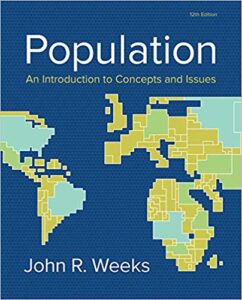Description
Test Bank For Population An Introduction to Concepts And Issues 12th Edition By John R
CHAPTER TWO
GLOBAL POPULATION TRENDS
LEARNING OBJECTIVES
- Become familiar with the basic historical facts of world population growth.
- Understand how and why the world’s population is distributed as it is around the globe.
- Understand the current regional patterns of population size and growth in all parts of the world.
- Comprehend the major regional demographic contrasts that exist today.
MAIN POINTS
- During the first 90 percent of human existence, the population of the world had grown only to the size of today’s New York City.
- Between 1750 and 1950, the world’s population mushroomed from 800 million to 2.5 billion, and since 1950 it has expanded to more than 7 billion.
- Despite the fact that humans have been around for tens of thousands of years, more than 1 in 10 people ever born is currently alive.
- Early population growth was slow not because birth rates were low but because death rates were high; on the other hand, continuing population increases are due to dramatic declines in mortality without a matching decline in fertility.
- World population growth has been accompanied by migration from rapidly growing areas into less rapidly growing regions. Initially, that meant an outward expansion of the European population, but more recently it has meant migration from less developed to more developed nations.
- Migration has also involved the shift of people from rural to urban areas, and urban regions on average are currently growing more rapidly than ever before in history.
- Although migration is crucial to the demographic history of the United States and Canada, both countries have grown largely as a result of natural increase—the excess of births over deaths—after the migrants arrived.
- At the time of the American Revolution, fertility levels in North America were among the highest in the world. Now they are low, although not as low as in Europe.
- The world’s 10 most populous countries are the People’s Republic of China, India, the United States, Indonesia, Brazil, Pakistan, Nigeria, Bangladesh, Russia, and Japan. Together they account for 59 percent of the world’s population.
- Almost all of the population growth in the world today is occurring in the less developed nations, leading to an increase in the global demographic contrasts among countries.
EXAMINATION QUESTIONS
Multiple-Choice (Choose the single best answer—the page where the answer is found is indicated in parentheses)
- The world’s population at the time of the Agricultural (Neolithic) Revolution was approximately
- 4 million. (26)
- 40 million.
- 400 million.
- 4 billion.
- Carrying capacity is lower for hunter-gatherers than for agriculturists because
- their death rates are higher.
- they use the land extensively rather than intensively. (26)
- they have fewer technological skills.
- birth rates regularly exceeded death rates.
- Between the third and fifth centuries A.D. the world’s population declined somewhat, probably due to
- the impact of Indonesian volcanic eruptions.
- higher mortality brought on by the early days of the Little Ice Age.
- the collapse of the Roman Empire and famine and floods in China. (27)
- the Irish Potato Famine.
- Europe’s population began to grow between 1650 and 1850 because of all of the following except
- the disappearance of the plague.
- an increase in the birth rate. (27)
- the introduction of the potato from the Americas.
- changes in agricultural practices.
- Two hundred years ago, the world’s population was approximately
- 100 million.
- 200 million.
- 1 billion. (28)
- 2 billion.
- Current projections from the United Nations suggest that we could reach a population of 10 billion by approximately
- 2020.
- 2040.
- 2060. (28)
- 2080.
- The total population of the world is currently increasing by about _____ million people per year.
- 20
- 40
- 60
- 80 (29)
- The Persian chess board story illustrates the concept of
- the Queen as embodiment of female empowerment.
- the power of doubling. (31)
- logarithm growth.
- carrying capacity.
- Population growth was slow for most of human history because
- death rates were very high. (32)
- abortion rates were very high.
- people preferred small families.
- low levels of technology always lead to low rates of growth.
- The most important reason for the massive increase in the human population over the past 200 years is
- the Green Revolution that increased agricultural productivity.
- the increase in the birth rate.
- technology that has made it possible for humans to live in more places.
- the decline in the death rate. (33)

Reviews
There are no reviews yet.